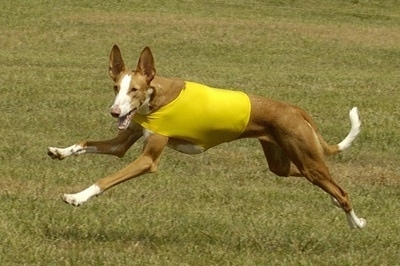
Bridge (Alisian FIelds Stirling Bridge One SC), a female, smooth Ibizan Hound, at 2 years old, lure coursing
Ih-BEEZ-an Hound 
The Ibizan Hound is also called Podenco Ibicenco. The body is fine-boned and slender. The head is long and narrow with a long muzzle that tapers to a point, giving the appearance of a cone. It has a very small stop. The nose is a rosy flesh color. The teeth meet in a scissors bite. The small eyes are a clear amber to caramel in color. The erect ears are large and pointed. The neck is long, slender and slightly arched. The back is level and straight. The chest is long and deep. The front legs are straight. Dewclaws may be removed. There are three varieties of Ibizan: smooth-haired, longhaired and wirehaired. The most common is the smooth-haired and the longhaired is very rare. The wirehaired has a longer coat of rough hair that is softer textured than the other two varieties. Colors are white and red, white and tan, solid white or red or a tawny tan coat color with darker shading, called a lion color.
The Ibizan Hounds, sometimes called "Beezers" by their fanciers, are quiet, clean, playful and polite. Good with children, gentle, sensible and sensitive. Protective and somewhat independent, they will hold back watchfully with strangers. Once they decide the stranger means no harm, they will relax very quickly. Be careful with small pets such as rabbits, cats and rodents; the Ibizan Hound is bred to hunt these creatures. Cats that are raised with the Ibizan Hound will fit in just fine as part of the "family pack," but it will chase and possibly kill a cat it does not know. As with all breeds, the Ibizan Hound should be well socialized with other dogs, other animals, adults and children. Beezers are pack animals by nature, so introducing a puppy to the household is easy. An Ibizan thinks its humans are its pack, so any addition (human visitor or new baby) must be introduced slowly. When introducing an adult dog, be sure to take both dogs together on a pack walk, making both dogs heel on the walk before bringing the new dog home. Ibizans are members of the family. They cannot be kept as kennel dogs. They love their humans, are as clean as a cat, and respect the rules of a household. This breed blushes when it gets excited, as does the Pharaoh Hound. Ibizans like to learn and do so very quickly. They are trainable, but tend to be willful if they sense their owners are meek or passive and get bored easily. Provided they have been properly trained, they can participate in many types of dog sports. These dogs are very sensitive to the voice of their handler and a friendly, calm, but assertive command will always achieve more than a harsh command. This breed tends to have large litters. As with all dogs, be sure you are always your dog’s pack leader to avoid any negative or unwanted behaviors. Proper human to canine communication is essential.
Height: 22 - 29 inches (56 - 74 cm)
Weight: 42 - 55 pounds (19 - 25 kg)
The Ibizan Hound is hardy and strong, but can have allergic reactions to drugs, including insecticides and flea powders. Some lines seem to be prone to seizures. The Ibizan Hound has a genetic propensity for Axonal Dystrophy, nerve and muscle disease.
The Ibizan Hound will do okay in an apartment if it is sufficiently exercised. It is moderately active indoors and will do best with at least a large yard. The Ibizan Hound can jump very high from a complete standstill, enabling him to easily jump most fences. An incredibly fast dog, the Ibizan Hound can be extremely difficult to recapture. This breed is a sighthound, meaning it hunts by sight rather than scent. Ibizans have selective hearing and an independent nature. They will take off running and WILL NOT return until they feel like it. The strong chase instinct and lack of caution in traffic can lead to disaster. A large fenced area is best for regular exercise. Breed Club literature suggests at least 40x60 feet. The breed is quite sensitive to cold, as his coat is not very protective.
This breed requires a great deal of exercise. It should have at least two to three long walks a day in order to satisfy the migration instinct. While out on the walk make sure the dog heels beside or behind the person holding the lead, never in front, as instinct tells a dog the leader leads the way, and that leader needs to be the human. This breed should get a chance to stretch its legs with a nice run once a day. Your dog will highly enjoy retrieving for you and will also enjoy running alongside your bicycle, but don't do this until your dog is fully grown as it can harm a young puppy. Do not let this breed off the lead unless you are in a secure area. This independent sighthound is extremely fast and it will take off and not come back until it is good and ready to. They are extremely hard to recapture. Keep in mind that the Ibizan Hound can jump very high from a complete standstill, enabling him to easily jump most fences.
About 10-12 years.
About 6 to 12 puppies
There are three varieties of Ibizan: smooth-haired, longhaired, and wirehaired. None of these varieties requires much attention. The shine on the coat of the smooth-haired can be kept in good condition by occasionally running a rubber glove over it. The wirehaired does not need hand-plucking. All can be groomed by an occasional brushing. Check at frequent intervals that the ear passages are clean and keep the claws short. This breed is an average shedder.
The Ibizan Hound is very similar to the Pharaoh Hound, with the main difference being coat color and the Ibizan's larger size. Depictions of dogs that looked much like today's Ibizan Hound were found in ancient Egypt around 3400 BC. It is thought that sea traders brought these dogs to the island of Ibiza, along with other surrounding islands off the coast of Spain about 700-900 BC. The dogs were used to hunt rabbit, providing food for the islanders. The dogs also hunted for themselves as they were not fed by the humans. This fast, hunting Greyhound type is able to hunt in both daylight and night. They hunt by sight, hearing and smell, alone or in packs. When the prey is discovered, the Ibizan points and when it bolts, the dog's sighthound instincts come into play and the hound is full-flight in strong pursuit. When the prey is captured the dog can be trained to bring it back to the hunter like a retriever. The Ibizan Hound is often used in the sport of lure coursing. It was recognized by the AKC in 1978.
Southern, AKC Hound
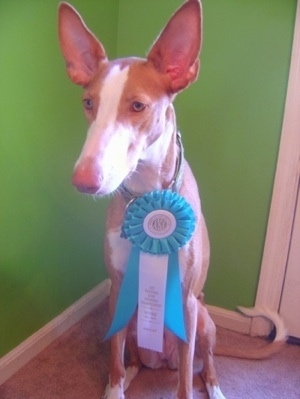
Bridge (Alisian FIelds Stirling Bridge One SC), a female, smooth Ibizan Hound at 2 years old—"She's a show dog and a lure courser."
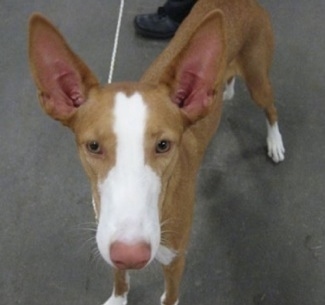
Bridge (Alisian Fields Stirling Bridge One SC), a female, smooth Ibizan Hound at 2 years old—"She's also a champion snuggler and professional couch hog. :)"
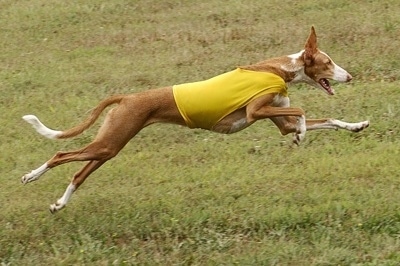
Bridge (Alisian Fields Stirling Bridge One SC), a female, smooth Ibizan Hound, at 2 years old, lure coursing
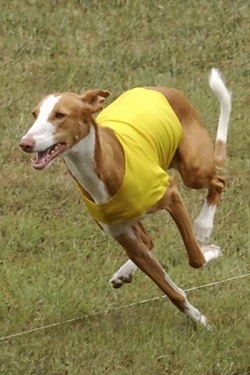
Bridge (Alisian Fields Stirling Bridge One SC), a female, smooth Ibizan Hound, at 2 years old, lure coursing
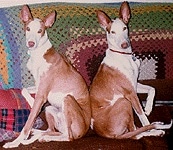
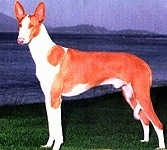
Photos courtesy of Rose Bednarski, Rose's Homepage
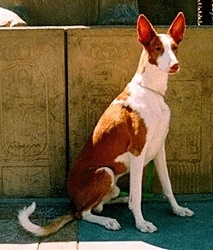
Photo courtesy of Rose Bednarski, Rose's Homepage
Wirehaired Ibizan Hound—Photo courtesy of WildWood Ibizan Hounds
Wirehaired Ibizan Hound—Photo courtesy of WildWood Ibizan Hounds
Wirehaired Ibizan Hound looking up a tree—Photo courtesy of WildWood Ibizan Hounds
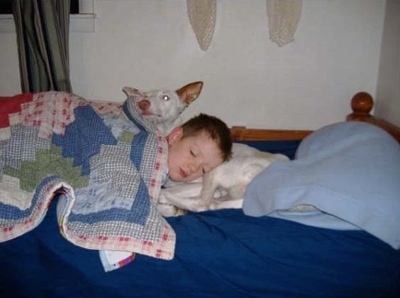
"This little female Ibizan Hound likes to cuddle with the kids in bed."
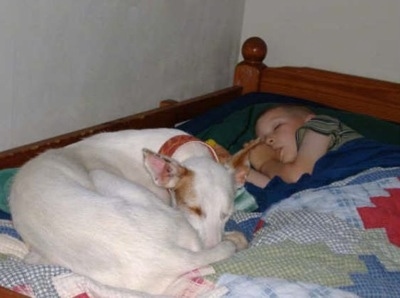
"This is a small adult Ibizan female that stayed with us for a little while. She loved to cuddle in bed with the kids! She usually tucked her nose under her tail when she slept. She knew she was not allowed to get on the couch, but would reason in her mind that a pillow on the couch or folded laundry on the couch was fine to curl up on. We laughed at her unashamed face as she nestled in a tight ball only touching the pillow or laundry. Ibizans are very expressive and fun to 'talk' to. Their ears speak what they are thinking similar to how a horse's would. I wanted to share this to spread how sweet the Ibizan breed is."